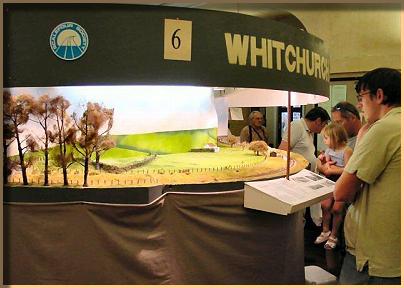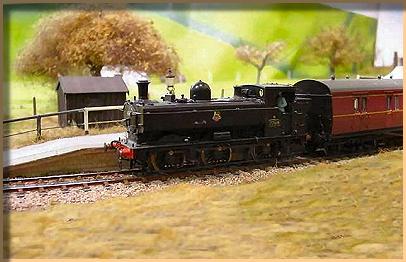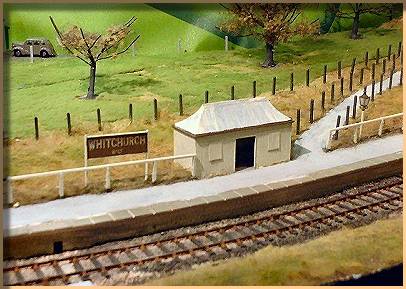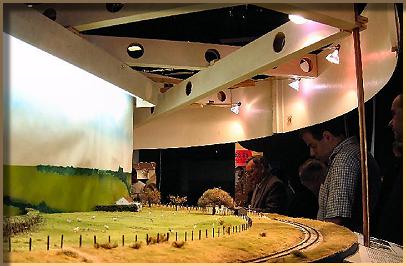Whitchurch Halt – a 1950's wayside halt
by Tim Venton
(with some extra pictures courtesy of David Braim, and David Lane and the Scalefour Society)
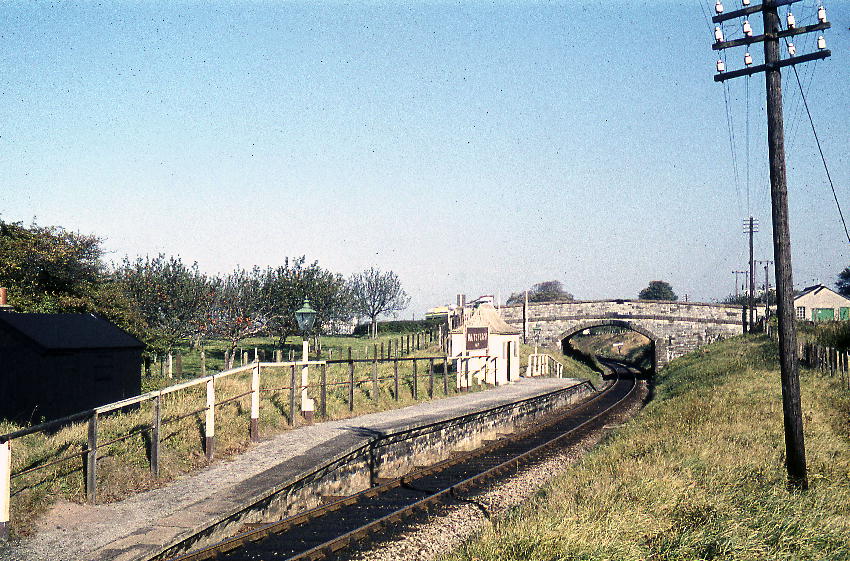
Whitchurch Halt, shortly before closure. Picture permission of and copyright Malcolm Braim
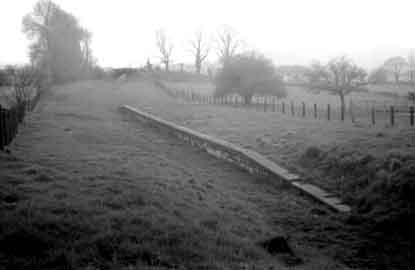
The view from the A37 bridge in 1976, just before the cutting containing the halt was filled in. |
The prototypeWhitchurch Halt was opened in 1925, and was situated 4m 15c from Bristol Temple Meads on the Bristol & North Somerset line. The halt was built within the boundaries originally purchased, and no new land was bought. It was located adjacent to the A37 Wells Road. A standard pagoda was on a wooden (?) platform, which was replaced later with a breeze block platform. A ramp runs down from the A37 road. Behind the halt is an orchard, but it also contains a hawthorn tree. To the south a large elm tree was near some poplars.
Following closure to passengers of the whole line on 31 October 1959, the line remained open for freight until a major landslip blocked the line near Pensford on 14 July 1968. The line between Radstock and Mells Road (closed 1966) was reinstated so the coal trains from the Somerset coalfield could resume their now circuitous route to Portishead power station. The line through Whitchurch was then closed and lifted.
Apparently after 1959, the pagoda waiting shelter lost its roof, which remained on the grass nearby for sometime in the 1960s. Track was removed c 1970, but the site remained relatively untouched until it was filled in late 1976. At the time of writing, both bridges remain, the occupation bridge is extremely dilapidated while the A37 bridge is very nearly filled in. The rest of the site has been levelled, the apple trees remain, but the elm tree has of course disappeared.
|
The model
Whitchurch Halt was my previous layout, started in September 1984. It was originally conceived and built because at that time there were no continuous runs to my knowledge available locally to test P4 models on. It was inspired by the Ian Futers layouts of the early '70s. Whitchurch Halt fitted the bill as the prototype, and I had taken a lot of pictures and measurements just before the site had been filled in. Though I set out with the intention of making a test track, it grew and the fiddle yard became more complicated. It has been subject to at least two major rebuilds. It was very successful as a test track, and also went to a number of exhibitions. It still exists today. When I first ran locos around it I remember, they made a couple of circuits and failed. The gearbox seized, or the motor overheated. I then had to rebuild them. It made me improve my engineering standards. (The text of the exhibition handout, dating from 1988, is given below.)
| A brief look at early constructional details, the scenery was built up with card on edge to get the profiles, laid over with a card top surface. This is the original pagoda by Mikes Models, later replaced by a scratchbuilt example. The bridge was built in plasticard, overlaid with Peco 'N gauge moulded stone'. The platform edge was scratch built. All these techniques were later used on Clutton. Photo taken July 1986. | 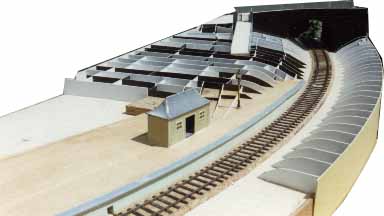
|
| This very early picture of the fiddle yard shows just three roads, it later grew and grew with more sidings and through routes. Problems with the limitations of this yard made me seriously look at how the fiddle yard was laid out when I was planning Clutton. Unfortunately, I didn't take enough much notice as Clutton's fiddle yard is on the small side. Look at that old Scalespeed controller! |  |
The baseboards are unconventional, the tops and ends are 6mm ply, while the front and backs are of 4mm ply. The front was scored to facilitate its being bent. Underneath, various blocks and off cuts were put in to strengthen the boards. The legs are separate, alignment between the boards is with Scalefour society joiners and G-clamps hold everything together.
Trackwork is straightforward riveted ply sleepers, stained with Colron dark oak wood dye, MJT cosmetic chairs, mounted on cork tiles that are super elevated. In the fiddle yard, ordinary copper clad sleepers are used. Steel rail is used throughout, I now swear by steel rail, at exhibitions the rail is only spot cleaned. So long as the layout is kept in a dry place, rusting does not happen.
As the layout progressed, I realised it would be interesting to actually run a full service of trains and maybe exhibit the layout. The fiddle yard expanded dramatically, from one loop to at present three long loops, four dead-end sidings plus a runround loop.
Structures are scratchbuilt from plastic sheet. The platelayers' hut though started life as a Cooper-Craft kit, although the chimney was moved. I don't normally use kits, but had no information (at the time) on the hut other than the roof profile and where the chimney was, and as the kit had the same roof profile I used it. Better information has not been forthcoming over the years, so it stays.
People are often surprised at the sheer size of the structures on the layout. The main A37 road bridge is 40' wide, and the accommodation bridge is 16' wide. Most model railway bridges are under width, so check with the prototype on your next bridge.
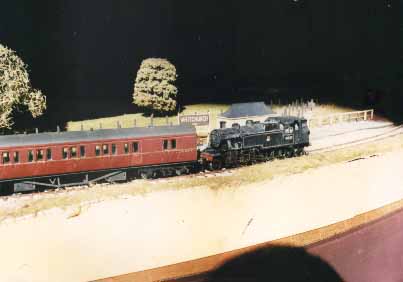
41202 arrives on an up train (Railwells 1987) |
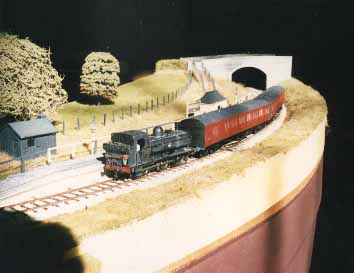
4636 on a down train arrives at Whitchurch (Railwells 1987) |
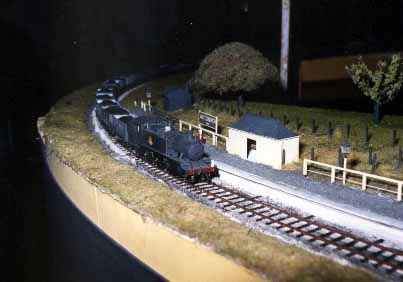
4131 on the up 5.00pm freight plods through (Scaleforum 1988) |
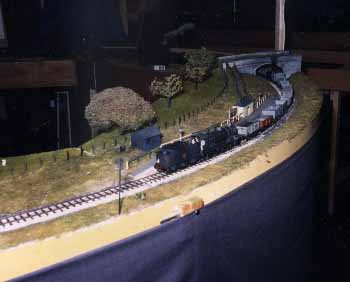
3032 on the down 2.5pm down freight (Scaleforum 1988) |
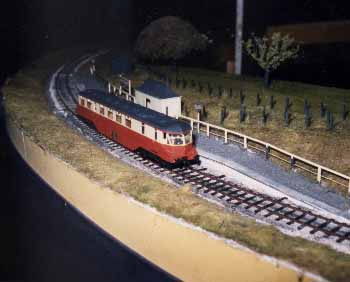
W23W on the up 6.6pm all station stopper (Scaleforum 1988) |
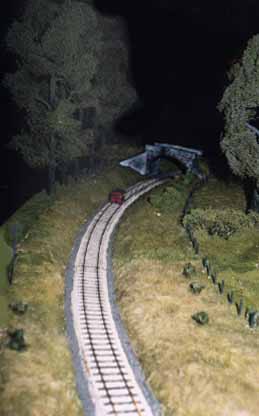 |
A Wickham trolley passes the large elm and poplars at the down end of the layout (Scaleforum 1988) |
The layout was refurbished after I agreed to take it to Railwells for a second visit in August 2003. This involved new lighting, Digital Command Control, point motors in the fiddle yard and even new boards in the middle and a back scene. The result of all this was a new look for the layout. I saw it as a test bed for ideas that I am now incorporating into Clutton. After over 20 years, the layout was showing its age, but in terms of proving constructional techniques, it did the job. I would not build a layout this way again though. Of course the stock readily transferred to the new layout. Regrettably, a lot of the engines shown here were stolen in 1992. I still have not got around to replacing all of them.
The following pictures were taken by David Lane at Scalefour Southwest August 2003
Lessons learned
What this layout taught me was that it is difficult to change the concept of a layout after it has been started. The problem is the fiddle yard, which isn't big enough, and in which trains have to be backed into sidings. I have decided to design the fiddle yards first next time and build the layout around it.
Exhibition handout, dating from 1988
Ever been dissatisfied with shunting 7 wagons around your branch line terminus? I have. I like long trains. In a quest for the minimum space layout (!) with long trains, here is Whitchurch Halt (W.R.). 'Wot, no station? NO SHUNTING!' (Gasp). Ever tried shunting a train 6–7ft long? I have done it, its great fun, but look at the room it takes up. 'Oh well', you say 'I won't bother to look at it, no shunting – no good'. But wait a minute, isn't that an old ex-ROD clanking through on the 2.05 ex Bristol East Depot with 27 on the back? Or a pannier on a B-set? There may be no station to shunt (mainly because points on a curve this sharp start looking wrong) but I can run trains representing a day's service through the Halt.
Why Whitchurch Halt? (a) it was on the line I have taken a special interest in – the Bristol & North Somerset, (b) I had a lot of information on it, (c) the 2 bridges formed admirable end stops to the scenic section. I worked out I could get a scale length model onto half the diameter of a 4'3" curve, leaving the other half for a fiddle yard.
So what do we end up with? A small wayside halt with all structures and trees in their correct relationship to each other, albeit around a curve much sharper than the prototype. Through this scene, typical trains representing a day's service run. Just think how commonplace such sights were during the 1950s. You will see panniers, prairies and ex LMS class 2s on passenger, and depending on whether its 1955 or 1957 in the timetable either the ROD or the large prairie. You will see the up Channel Islands Express connection to Bristol (pannier with 'A' headlamps and Bset!) followed by the railcar. You may also see some foreign stock operated by other members of the Avon & Somerset Group - so Bulldogs and bogie tanks may also be seen. I hold no responsibility as to their prototype accuracy on the branch!
Constructional details, baseboards are of 4mm and 6mm plywood, arranged in an open box construction, braced with scraps of wood. The boards and legs are simply G clamped together, using Society dowels for alignment. Scenic track is quite conventional, (for the time, it was whitemetal chairs on ply and rivet sleepers) copper clad is used in the fiddle yard, steel rail is used throughout. The platelayers hut is modified Coopercraft, the rest of the structures are scratchbuilt. Most locos run on split frames and are powered by Portescaps. Control is by LM317 voltage regulator, housed in a small tin.
Chronology
|
| 1873 | Bristol & North Somerset opened |
| 1 January 1925 | Halt opened |
| 31 October 1959 | Halt closed |
| 18 April 1976 | Visit to measure up, just before the site was filled in |
| September 1984 | Baseboards started |
| 7 November 1984 | Site visit to measure bridges |
| December 1984 | Baseboards made, track begun, no baseboard joiners at this stage |
| 1985 | Intermediate stage on fiddle yard with crossover in middle |
| June 1985 | Layout running |
| July 1986 | Fiddle yard altered |
| August 1987 | Railwells |
| September 1988 | Scaleforum |
| 28 October 1989 | Keynsham Lions show |
| June 1992 | Scalefour AGM |
| 18/19 November 1989 | Brunel Exhibition, Bristol Temple Meads |
| April 2002 | Layout rescued, minor repairs done on point switches. Main job was to give it a good vacuum |
| February 2003 | Platelayers hut being rebuilt, new coping stones on bridges |
| May 2003 | Finally started the lighting rig |
| August 2003 | Scalefour South West (Railwells) |
| March 2004 | Scalefour North |
|










